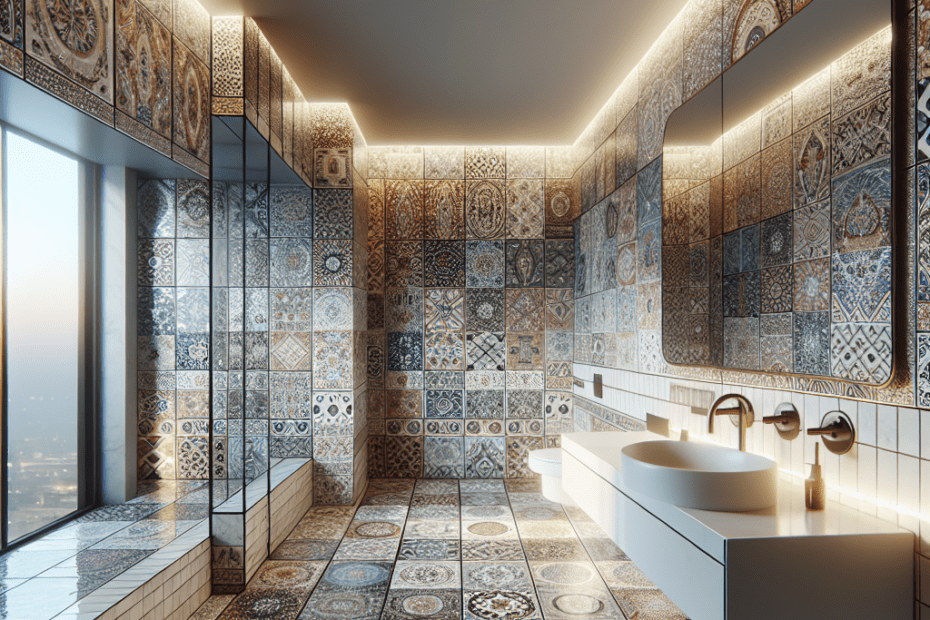Transforming Bathrooms with Patterned Tiles
In recent years, homeowners have found new and exciting ways to make their bathrooms stand out. One trendy and visually appealing way to breathe life and personality into a bathroom space is by using patterned tiles. Known for their versatility and design potential, patterned tiles in bathrooms can serve as a magnificent focal point, adding enviable style and elegance.
Why Choose Patterned Tiles?
Patterned tiles are available in a plethora of colors, shapes, and styles, allowing homeowners to choose designs that fit their unique tastes and the functional needs of their space. According to a report by Houzz, 66% of renovating homeowners in 2021 incorporated tile materials in their bathroom projects, with stunning patterned tiles being a popular choice.
Different Areas to Use Patterned Tiles
| Bathroom Area | Design Impact |
|---|---|
| Shower Walls | Creates a focal point and adds depth |
| Flooring | Brings an artistic element and charm |
| Accent Walls | Makes a bold style statement |
| Around Vanities | Adds sophistication and elegance |
Using Patterned Tiles on Shower Walls
Shower walls are perfect canvases for patterned tiles. Introducing patterns can transform the simple space into a work of art. Designers often recommend using contrasting grout colors to highlight the patterns, thus enhancing the overall visual appeal. This not only works aesthetically but also helps protect walls from water damage, according to the National Tile Contractors Association.
Patterned Tile for Flooring
Patterned tiles on bathroom floors can infuse the space with energy and creativity. A visually appealing floor design can set the tone for the rest of the bathroom’s decor. It’s essential to consider tile size when working with floors; smaller bathrooms might benefit from larger tiles, as they can make the space feel larger, according to the Tile Council of North America.
Accent Walls Create Visual Interest
Accent walls made from patterned tiles can add dimension and drama to a bathroom. Whether it’s behind a bathtub or above a sink, these walls captivate attention and can serve as inspiration for other design elements within the room. Complementing these patterns with neutral tones in the rest of the bathroom can prevent overwhelming the space.
Highlighting Areas Around Vanities
The area around bathroom vanities offers another excellent opportunity for using patterned tiles. This addition can elevate the sophistication of the space, turning a functional area into a fashion statement. Tiles in rich colors and intricate designs can be offset with modern fixtures, creating a stunning yet harmonious environment.
Statistics Supporting Patterned Tile Popularity
The appeal of patterned tiles in bathroom renovations is supported by industry data. The Tile Association notes a significant increase in the use of bold and colorful tiles, with over 30% of contractors reporting a surge in orders for patterned designs within the past two years. This trend is expected to grow as more homeowners seek to create unique and personalized spaces.
Key Takeaways
- Patterned tiles provide a versatile and artistic design option for bathrooms.
- These tiles can be used in various bathroom areas, including floors, walls, and showers.
- They contribute to both visual appeal and functional durability.
- Current trends show a growing preference for patterned tiles in bathroom renovations.
FAQ Section
- Q: Why are patterned tiles popular for bathrooms?
- A: They are versatile, add artistic value, and come in various designs and colors.
- Q: Can patterned tiles make a small bathroom look bigger?
- A: Yes, using larger patterns or tiles can give the illusion of a larger space.
- Q: Are patterned tiles more expensive than plain tiles?
- A: It depends on the material and design, but they can be comparable in price.
- Q: Do patterned tiles require special maintenance?
- A: No special maintenance is needed, but regular cleaning is recommended to preserve their appearance.
- Q: Are there any drawbacks to using patterned tiles?
- A: Overusing them can overwhelm a space, so balance is crucial in design.
